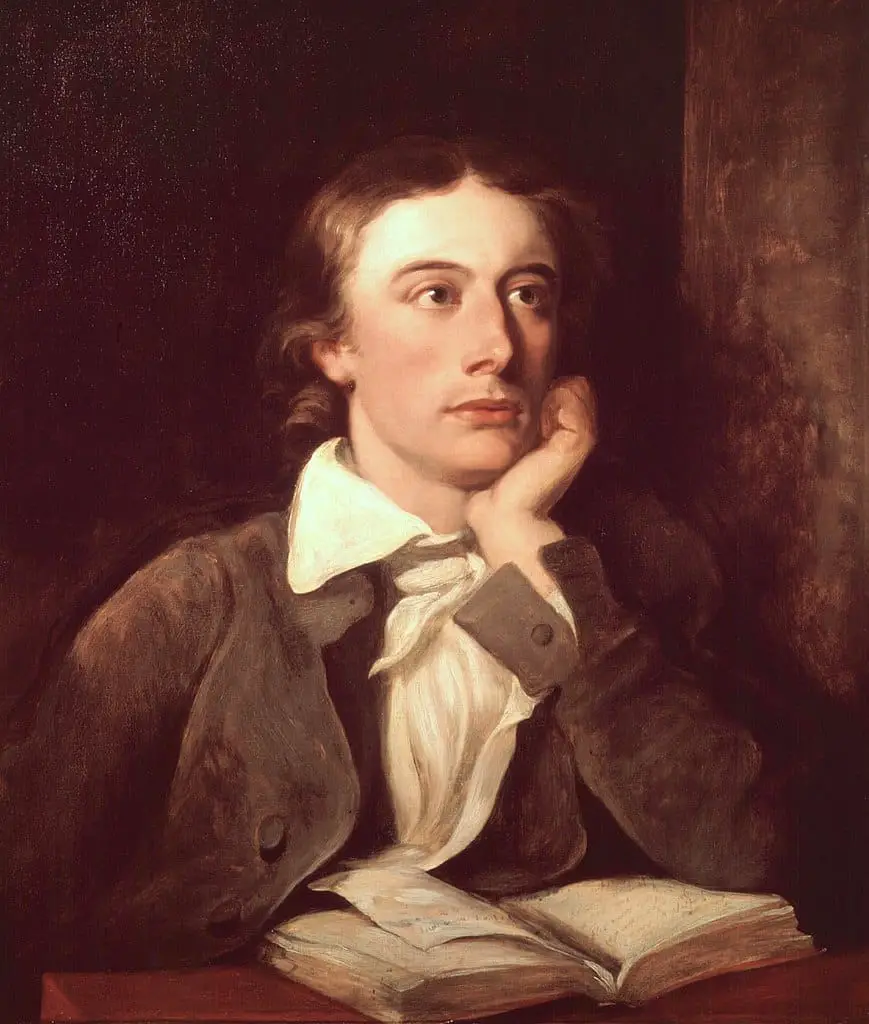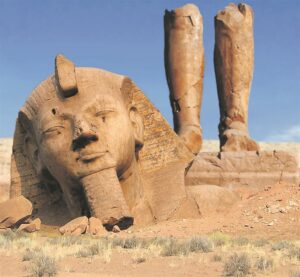
FULL POEM - SCROLL DOWN FOR LINE-BY-LINE ANALYSIS
Season of mists and mellow fruitfulness,
Close bosom-friend of the maturing sun;
Conspiring with him how to load and bless
With fruit the vines that round the thatch-eves run;
To bend with apples the moss’d cottage-trees,
And fill all fruit with ripeness to the core;
To swell the gourd, and plump the hazel shells
With a sweet kernel; to set budding more,
And still more, later flowers for the bees,
Until they think warm days will never cease,
For summer has o’er-brimm’d their clammy cells.
Who hath not seen thee oft amid thy store?
Sometimes whoever seeks abroad may find
Thee sitting careless on a granary floor,
Thy hair soft-lifted by the winnowing wind;
Or on a half-reap’d furrow sound asleep,
Drows’d with the fume of poppies, while thy hook
Spares the next swath and all its twined flowers:
And sometimes like a gleaner thou dost keep
Steady thy laden head across a brook;
Or by a cyder-press, with patient look,
Thou watchest the last oozings hours by hours.
Where are the songs of spring? Ay, Where are they?
Think not of them, thou hast thy music too,—
While barred clouds bloom the soft-dying day,
And touch the stubble-plains with rosy hue;
Then in a wailful choir the small gnats mourn
Among the river sallows, borne aloft
Or sinking as the light wind lives or dies;
And full-grown lambs loud bleat from hilly bourn;
Hedge-crickets sing; and now with treble soft
The red-breast whistles from a garden-croft;
And gathering swallows twitter in the skies.

SUMMARY AND CONTEXT
‘To Autumn’ serves as the last of Keats’ six famous “1819 odes” as well as his last major composition before his death one year later. An ode is a short, lyrical poem consisting of three sections (the strophe, the antistrophe and the epode) usually praising a person or the natural world, in this case, the season Autumn. ‘To Autumn’ consists of three eleven-line stanzas, forming the strophe, antistrophe and the epode of the ode respectively. There is no definitive rhyme scheme throughout, however, consistency is shared between the stanzas: each begins with an ABAB-rhymed quatrain which is then lost in the following lines and the rhyming loses a set meter, followed by lines nine and ten forming rhyming couplets. This gives the structure a cyclical quality – with the pattern of the rhyme at the beginning and end of each stanza adding symmetry, akin to the cyclical nature of time and the seasons. The progression of each stanza signifies the passing of time – describing both the passing of the season (from its inception in the first to its decline in the third) as well as the progression of an autumnal day (from dawn in the first to dusk in the last). The progression of the season from late summer to early winter parallels satisfyingly with the progression of a single day from dawn till dusk.
LINE-BY-LINE ANALYSIS
STANZA 1
Season of mists and mellow fruitfulness,
The speaker addresses autumn itself in the opening line, similar to the way in which Keats would address a lover in his romantic work. This, along with the soft, luscious image of ‘mellow fruitfulness’ encapsulates his adoration for the season.
Close bosom-friend of the maturing sun;
Conspiring with him how to load and bless
These two lines describe the alliance between the ‘maturing sun’ and the season autumn. The sun is a symbol of warmth, growth and passion. This alliance seeks to ‘load and bless’, in other words, add power, prosperity and vitality to the natural world.
With fruit the vines that round the thatch-eves run;
To bend with apples the moss’d cottage-trees,
The sun and autumn ‘load and bless’ the earth with fruits growing on the vines and apples growing on the trees. Thereby, this alliance breeds and enables life on earth by bestowing these fruits upon them, consequently giving autumn and the sun godly qualities.
And fill all fruit with ripeness to the core;
To swell the gourd, and plump the hazel shells
The imagery of ‘ripeness to the core’ and ‘plumb the hazel shells’ signify perfection in a climatic sense. Autumn represents the climax where the fruits of the summers’ labour are reaped, before the descent into winter and the death and desolation it brings.
With a sweet kernel; to set budding more,
And still more, later flowers for the bees,
Until they think warm days will never cease,
The ‘sweet kernel’ is the softer, edible part of a nut surrounded by the shell. Its sweetness implies a sense of pleasure in the surrounding autumnal environment. The phrase ‘to set budding more, and still more’ infers that Keats is describing the beginning of Autumn in this first stanza, as new life and growth is still taking place – there is a full sense of security, appearing that the autumnal buffer to the harshness of winter is plentiful.
For summer has o’er-brimm’d their clammy cells.
This line is another description of nature profiting in autumn from heightened productivity in the summer months. The impression is given that summer is the period of labour, the fruits of which can then be reaped and enjoyed in autumn – a reason why Keats views the season with such fondness. The ‘clammy cells’ in this case is the honeycomb made by the bees.
STANZA 2
Who hath not seen thee oft amid thy store?
Whilst the speaker was directly addressing autumn in the first stanza, the connection between both entities grows with the use of the personal pronoun ‘thee’ (archaic form of you) at the beginning of the second stanza which personifies the autumn. The speaker also describes the season as a visible entity – questioning whether the bees can see the autumn amid their saturated honeycomb stores.
Sometimes whoever seeks abroad may find
Thee sitting careless on a granary floor,
The imagery of autumn ‘sitting careless on a granary floor’ has a multitude of interpretations, both positive and negative. Potentially, the image could signify the relaxing, peaceful quality of the autumnal environment – picturing the season enjoying a well-earned respite after a productive summer. However, it is argued that the lethargy of the image could be a metaphor for Keats’ ill-health at the time and his impending premature death.
Thy hair soft-lifted by the winnowing wind;
Keats’ wrote his poetry to appeal to the senses and this line is a perfect example. He personifies the autumn as a beautiful woman whose hair sways in the ‘winnowing wind’. This image appeals not just visually but through sound as well, thanks to the onomatopoeia of the ‘winnowing wind’ which is given rhythm by its alliteration. The sensory description attempts to capture the splendour of the season as closely as possible.
Or on a half-reap’d furrow sound asleep,
Drows’d with the fume of poppies, while thy hook
The theme of weariness is re-emphasised in these two lines. The conflict between the beauty of the autumn and the state of enervation of the season dominates the second stanza as a whole. It’s ambiguous whether Keats looks fondly or otherwise on the inactivity of autumn. It is clear, however, that sleep and drowsiness represent a vulnerability in literature which in this case is autumn’s vulnerability to the take over of the harsh winter months.
Spares the next swath and all its twined flowers:
This line reiterates the weariness of the autumn, which Keats personifies as a harvester, harvesting their fields. The autumn spares a whole area of ‘twined [interlacing] flowers’, however, again portraying the season as fatigued but also merciful.
And sometimes like a gleaner thou dost keep
Steady thy laden head across a brook;
A ‘gleaner’ is someone who picks up the remnants of grain left in the field by the harvesters. The speaker uses a simile to compare the autumn to one of these people laden with their collected grain, attempting to traverse a brook (a small river) – an image of poverty and desperation.
Or by a cyder-press, with patient look,
Thou watchest the last oozings hours by hours.
These two lines of the autumn patiently spending hours and hours watching the last drops of cider coming out of a ‘cyder-press’ is akin to the saying to “watch paint dry” and paints another weary, monotonous image. The repetition of the long vowels also reduces the rhythm of the poem to a snail’s pace, mirroring the slow passing of time in the narrative of the poem. This slow passing of time gives a false sense of security that the onset of winter is far from imminent.
STANZA 3
Where are the songs of spring? Ay, Where are they?
These two rhetorical questions immediately create a doubtful and confused tone in the final stanza. The speaker begs to know where spring has gone, either lamenting its passing previously that year or seeking its arrival in the next. The speaker seems eager for spring and the new life and hope that it signifies.
Think not of them, thou hast thy music too,—
This is the speaker reassuring himself – finding comfort in the autumnal sounds (this could be bird song or the wind, for example) as a replacement for those of the spring.
While barred clouds bloom the soft-dying day,
And touch the stubble-plains with rosy hue;
The clouds are ‘barred’, meaning they are streaked with bands of colour – red and orange sunlight in this case as the sun is setting, marking the ‘soft-dying day’. As mentioned in the summary, the poem narrates the passing of an autumn day in parallel with the season itself and this third stanza describes the conclusion of both, as daylight ebbs. Again, this is a potential metaphor for Keats’ death – wit the ‘soft-dying day’ acting as a metaphor for his life. This is further evidence to support the interpretation that the poem itself is an allegory for Keats’ death.
Then in a wailful choir the small gnats mourn
The imagery of a ‘wailful choir’ of gnats and the word-use ‘mourn’ are undoubtedly linked to death and funerals. What is ambiguous, however, is whether this emotive imagery is lamenting the death of autumn or of Keats himself – my belief is both.
Among the river sallows, borne aloft
Or sinking as the light wind lives or dies;
These two lines capture the interactions of the natural world, describing the gnats as being borne aloft as the wind lives and sinking as it dies. The juxtaposition of which elicits the harshness, mercilessness of winter (when the wind dies and they sink) compared to the forgiving tranquility of the autumn (when the wind lives and they die). This juxtaposing imagery implies that, as autumn ebbs away in the final stanza, Keats’ despair mounts in light of the impending winter.
And full-grown lambs loud bleat from hilly bourn;
The ‘lambs’, like spring, are a symbol of new life and hope – Keats is potentially finding solace upon observing them that the natural splendor of spring will reward him for enduring the harshness of winter.
Hedge-crickets sing; and now with treble soft
The red-breast whistles from a garden-croft;
And gathering swallows twitter in the skies.
The final three lines of the poem are of a contented, optimistic tone as the speaker draws pleasure from the beautiful sounds of autumn (the singing of the crickets and the whistling birdsong). This cheerfulness, however, is slightly undermined by the impending inevitability of winter as the conclusion of autumn is evident as the swallows gather in the skies – preparing to migrate southwards for winter.


